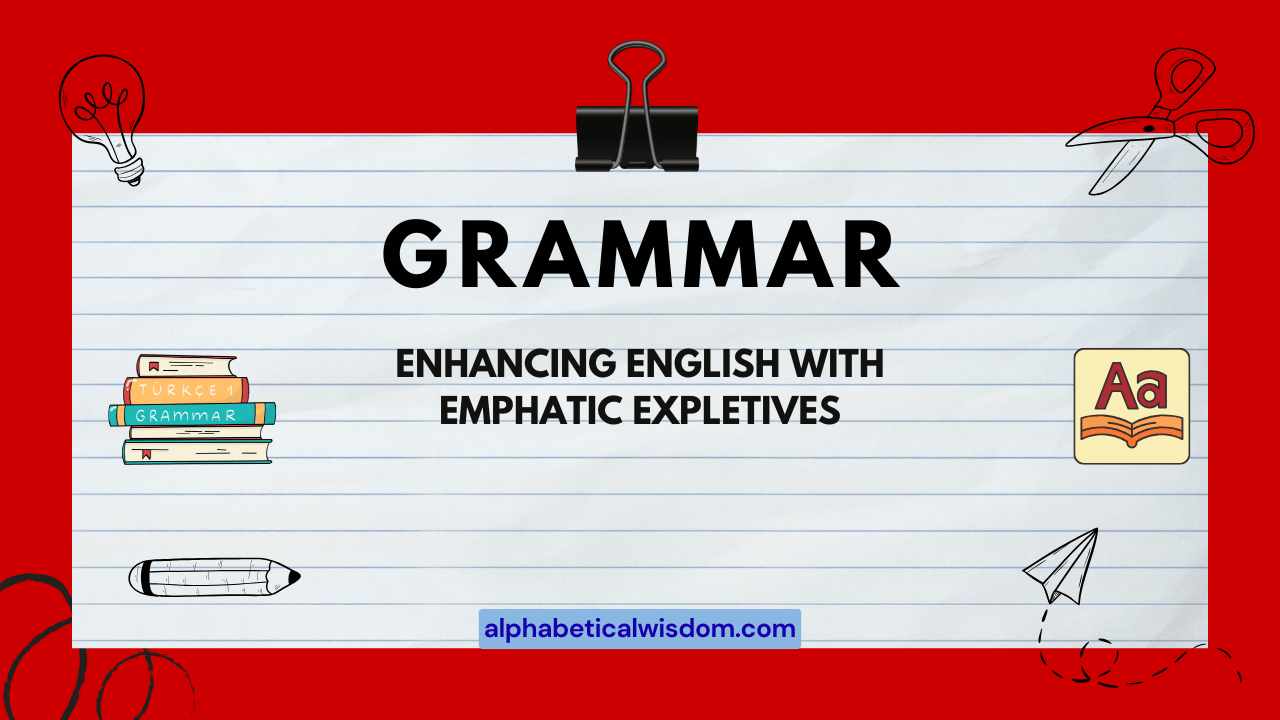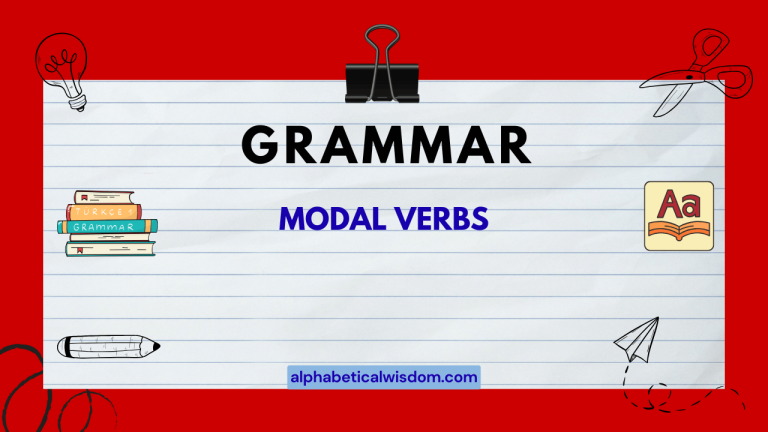Enhancing English with Emphatic Expletives: A Grammar Guide
Emphatic expletives, such as “there” and “it,” are grammatical tools used to shift sentence focus or introduce information without contributing to the core meaning. Understanding their function is crucial for constructing clear and effective sentences.
Mastering the use of emphatic expletives can significantly improve your writing and speaking skills, allowing you to create more nuanced and engaging communication. This guide is designed for English learners of all levels, from beginners to advanced speakers, who wish to refine their understanding and application of this essential grammatical concept.
Table of Contents
- Introduction
- Definition of Emphatic Expletives
- Classification
- Function in Sentences
- Contexts of Use
- Structural Breakdown
- “There” Structures
- “It” Structures
- Types and Categories
- Existential “There”
- Preparatory “It”
- Cleft “It”
- Examples of Emphatic Expletives
- Existential “There” Examples
- Preparatory “It” Examples
- Cleft “It” Examples
- Mixed Examples
- Complex Examples
- Usage Rules
- Subject-Verb Agreement
- Clarity and Conciseness
- Formal vs. Informal Usage
- Common Mistakes
- Subject-Verb Agreement Errors
- Redundancy and Overuse
- Misplaced Modifiers
- Practice Exercises
- Exercise 1: Identifying Emphatic Expletives
- Exercise 2: Correcting Sentences
- Exercise 3: Sentence Construction
- Advanced Topics
- Emphatic Expletives and Style
- Emphatic Expletives in Rhetoric
- FAQ: Frequently Asked Questions
- Conclusion
Definition of Emphatic Expletives
An emphatic expletive is a word that serves a grammatical function in a sentence without contributing to the core meaning of the sentence. It acts as a placeholder, allowing for shifts in emphasis or the introduction of new information.
The most common emphatic expletives in English are “there” and “it.” These words enable specific sentence structures that would otherwise be grammatically awkward or less effective.
Classification
Emphatic expletives are classified as function words, meaning they serve a grammatical purpose rather than carrying semantic content. They are sometimes referred to as “dummy subjects” or “empty subjects” because they occupy the subject position in a sentence without referring to a specific entity or concept.
The true subject of the sentence is typically found later in the sentence.
Function in Sentences
The primary function of emphatic expletives is to allow for variations in sentence structure that can improve clarity, emphasis, or flow. They enable the postponement of the real subject, which can be useful when introducing new information or when the subject is lengthy or complex.
They also allow the writer or speaker to emphasize certain parts of the sentence.
Contexts of Use
Emphatic expletives are used in various contexts, both formal and informal. They are common in descriptive writing, explanations, and introductions.
In formal writing, they can help to create a more objective or impersonal tone. In informal speech, they are used to ease the flow of conversation and to introduce new topics naturally.
Their use is particularly prevalent in situations where the speaker or writer wants to avoid beginning a sentence with a complex or unfamiliar subject.
Structural Breakdown
Understanding the structure of sentences using emphatic expletives is essential for their correct and effective use. The structures typically involve the expletive followed by a verb (usually a form of “be”) and then the actual subject of the sentence.
“There” Structures
Sentences using “there” as an emphatic expletive usually follow the pattern: There + be-verb + subject + [optional modifiers]. The verb must agree in number with the actual subject that follows. For example, “There is a book on the table” (singular) versus “There are books on the table” (plural). This structure is commonly used to indicate the existence or presence of something.
Consider the following examples to illustrate the structural breakdown of “there” sentences:
- There is a cat sleeping on the couch.
- There were several reasons given for the delay.
- There will be a meeting held next week.
“It” Structures
Sentences using “it” as an emphatic expletive can take several forms, but they often involve postponing the real subject to later in the sentence. Two common structures are: It + be-verb + adjective + to-infinitive and It + be-verb + that-clause. For example, “It is important to study” and “It is true that he left.” In these cases, “it” does not refer to anything specific but is simply a placeholder.
Here are some examples to illustrate the structural breakdown of “it” sentences:
- It is necessary to complete the assignment on time.
- It was surprising that she won the competition.
- It seems likely that they will arrive late.
Types and Categories
Emphatic expletives can be divided into different categories based on their specific function and the type of sentence structure they create. Understanding these categories can help you use expletives more effectively.
Existential “There”
The existential “there” is used to indicate the existence or presence of something. It is often followed by a form of the verb “be” and then the subject.
The subject is typically a noun phrase that represents what exists. This type of expletive is very common in descriptive writing and everyday conversation.
For example, “There is a problem” or “There are many opportunities.”
Preparatory “It”
The preparatory “it” is used to postpone the real subject of the sentence, which is often an infinitive phrase or a that-clause. This allows the writer or speaker to introduce the subject gradually and to emphasize other parts of the sentence.
For example, “It is important to be on time” (where “to be on time” is the real subject) or “It is clear that he is innocent” (where “that he is innocent” is the real subject).
Cleft “It”
The cleft “it” is used to emphasize a particular element of a sentence by dividing the sentence into two parts, with “it” acting as a connector. The structure is typically: It + be-verb + emphasized element + that-clause. For example, “It was John who broke the vase” (emphasizing John) or “It was yesterday that I finished the project” (emphasizing yesterday). This structure is useful for highlighting specific information and creating a more dramatic effect.
Examples of Emphatic Expletives
To fully understand the use of emphatic expletives, it is helpful to examine a variety of examples in different contexts. The following tables provide examples of existential “there,” preparatory “it,” and cleft “it” sentences.
Existential “There” Examples
The following table provides numerous examples of sentences using the existential “there.” Note how “there” allows the sentence to introduce the subject more naturally.
| Sentence | Explanation |
|---|---|
| There is a meeting scheduled for tomorrow. | Indicates the existence of a meeting. |
| There are several options available to you. | Indicates the existence of multiple options. |
| There was a loud noise outside. | Indicates the presence of a noise. |
| There will be changes made to the policy. | Indicates that changes will occur. |
| There has been an increase in sales this quarter. | Indicates an increase in sales. |
| There used to be a cinema in this town. | Indicates the past existence of a cinema. |
| There might be a chance of rain tonight. | Indicates a possibility of rain. |
| There could be more people coming later. | Indicates a possibility of more people arriving. |
| There should be enough food for everyone. | Indicates that there is likely enough food. |
| There must be a mistake in the calculations. | Indicates a belief that there is a mistake. |
| There isn’t any milk left in the fridge. | Indicates the absence of milk. |
| There aren’t many tickets left for the concert. | Indicates a limited number of tickets. |
| There wasn’t anyone at the door. | Indicates the absence of anyone at the door. |
| There won’t be any problems, I assure you. | Indicates an assurance that there will be no problems. |
| There hasn’t been a decision made yet. | Indicates that a decision is pending. |
| There stands an old oak tree in the park. | Indicates the presence of an old oak tree. |
| There lies a hidden treasure somewhere on this island. | Indicates the potential location of a hidden treasure. |
| There remains a question of how to proceed. | Indicates an unresolved issue. |
| There goes the last bus for the night. | Indicates the departure of the last bus. |
| There comes a time when you must make a decision. | Indicates the inevitability of making a decision. |
| There is no doubt about his talent. | Indicates certainty regarding his talent. |
| There are times when I miss my hometown. | Indicates occasional feelings of missing home. |
| There was a sense of excitement in the air. | Indicates the presence of excitement. |
| There will always be challenges to overcome. | Indicates the constant presence of challenges. |
| There has to be a better way to do this. | Indicates the necessity of finding a better method. |
Preparatory “It” Examples
The following table provides examples of sentences using the preparatory “it.” Notice how “it” allows the real subject (an infinitive or that-clause) to be placed later in the sentence.
| Sentence | Explanation |
|---|---|
| It is important to be punctual. | Postpones “to be punctual” as the real subject. |
| It is necessary to complete the application form. | Postpones “to complete the application form” as the real subject. |
| It is essential to have a valid passport. | Postpones “to have a valid passport” as the real subject. |
| It is difficult to learn a new language. | Postpones “to learn a new language” as the real subject. |
| It is easy to make mistakes when you are tired. | Postpones “to make mistakes” as the real subject. |
| It is clear that he is innocent. | Postpones “that he is innocent” as the real subject. |
| It is obvious that they are in love. | Postpones “that they are in love” as the real subject. |
| It is likely that it will rain tomorrow. | Postpones “that it will rain tomorrow” as the real subject. |
| It is possible that he has already left. | Postpones “that he has already left” as the real subject. |
| It is probable that the meeting will be canceled. | Postpones “that the meeting will be canceled” as the real subject. |
| It is surprising that she won the competition. | Postpones “that she won the competition” as the real subject. |
| It is amazing that he can speak five languages. | Postpones “that he can speak five languages” as the real subject. |
| It is wonderful that you are coming to visit. | Postpones “that you are coming to visit” as the real subject. |
| It is unfortunate that they had to cancel the event. | Postpones “that they had to cancel the event” as the real subject. |
| It is good to see you again. | Postpones “to see you again” as the real subject. |
| It is a pleasure to work with such a dedicated team. | Postpones “to work with such a dedicated team” as the real subject. |
| It is an honor to receive this award. | Postpones “to receive this award” as the real subject. |
| It is a privilege to be part of this organization. | Postpones “to be part of this organization” as the real subject. |
| It is unwise to ignore the warning signs. | Postpones “to ignore the warning signs” as the real subject. |
| It is foolish to believe everything you hear. | Postpones “to believe everything you hear” as the real subject. |
| It is said that honesty is the best policy. | Postpones “that honesty is the best policy” as the real subject. |
| It is believed that the Earth is round. | Postpones “that the Earth is round” as the real subject. |
| It is known that exercise is good for your health. | Postpones “that exercise is good for your health” as the real subject. |
| It is understood that you will keep this information confidential. | Postpones “that you will keep this information confidential” as the real subject. |
| It is expected that the project will be completed on time. | Postpones “that the project will be completed on time” as the real subject. |
Cleft “It” Examples
The following table provides examples of sentences using the cleft “it.” Notice how “it” is used to emphasize a specific part of the sentence.
| Sentence | Explanation |
|---|---|
| It was John who broke the vase. | Emphasizes John. |
| It was yesterday that I finished the project. | Emphasizes yesterday. |
| It is the economy that is the main concern. | Emphasizes the economy. |
| It was because of the rain that we stayed home. | Emphasizes the reason for staying home. |
| It is in Paris that they met for the first time. | Emphasizes the location of their first meeting. |
| It was her dedication that led to her success. | Emphasizes her dedication. |
| It is perseverance that is key to achieving your goals. | Emphasizes perseverance. |
| It was his kindness that impressed everyone. | Emphasizes his kindness. |
| It is knowledge that empowers us. | Emphasizes knowledge. |
| It was the challenge that motivated them. | Emphasizes the challenge. |
| It was the old house that they decided to buy. | Emphasizes the old house. |
| It is this book that I want to read. | Emphasizes this book. |
| It was the blue car that caught my eye. | Emphasizes the blue car. |
| It is this painting that is worth the most. | Emphasizes this painting. |
| It was the mountain that they climbed. | Emphasizes the mountain. |
| It was with great effort that he completed the task. | Emphasizes the effort involved. |
| It is with patience that we achieve our goals. | Emphasizes the importance of patience. |
| It was through hard work that they succeeded. | Emphasizes the role of hard work. |
| It is by learning from our mistakes that we grow. | Emphasizes the process of learning. |
| It was by sheer luck that they won the lottery. | Emphasizes the role of luck. |
| It is not the destination, but the journey that matters. | Emphasizes the journey. |
| It is not what you say, but what you do that counts. | Emphasizes actions over words. |
| It is not the years in your life, but the life in your years that matters. | Emphasizes the quality of life. |
| It is not the failure, but the fear of failure that stops us. | Emphasizes the fear of failure. |
| It is not the wealth, but the health that is true happiness. | Emphasizes the importance of health. |
Mixed Examples
Here are some examples that mix the uses of “there” and “it” for a broader understanding:
| Sentence | Explanation |
|---|---|
| There is a belief that it is important to recycle. | Combines existential “there” with preparatory “it.” |
| It is clear that there are many challenges ahead. | Combines preparatory “it” with existential “there.” |
| There seems to be a problem, and it is urgent that we address it. | Combines existential “there” with preparatory “it” and a reference to the problem. |
| It is said that there is no place like home. | Combines preparatory “it” with existential “there” in a common saying. |
| There is a rumor that it was he who made the decision. | Combines existential “there” with cleft “it” to emphasize who made the decision. |
Complex Examples
These examples show more complex sentence structures using emphatic expletives:
| Sentence | Explanation |
|---|---|
| There is no denying that it is essential to invest in education for future generations. | Complex sentence with existential “there” and preparatory “it.” |
| It is often said that there is an opportunity in every challenge, but it is up to us to find it. | Combines preparatory “it” and existential “there” with a concluding clause. |
| There used to be a time when it was believed that the Earth was flat, but now we know better. | Complex sentence contrasting past beliefs with current knowledge. |
| It is with great pleasure that there are new opportunities for growth and development in our community. | Complex sentence using preparatory “it” to introduce existential “there” with a positive message. |
| There is little doubt that it was her innovative approach that led to the project’s success, and it is a testament to her skills. | Combines existential “there” with cleft “it” to highlight the key factor in the project’s triumph. |
Usage Rules
Proper usage of emphatic expletives requires adherence to specific grammatical rules. These rules ensure that sentences are clear, grammatically correct, and effective.
Subject-Verb Agreement
When using “there,” the verb must agree in number with the actual subject that follows. This is a common source of errors, so it is important to pay close attention.
For example, “There is a cat” (singular) and “There are cats” (plural). The verb agrees with the *cat* and *cats*, respectively, not with “there.”
Clarity and Conciseness
While emphatic expletives can be useful, they should not be overused. Overuse can lead to wordy and unclear sentences.
If a sentence can be written more directly without an expletive, it is often better to do so. For example, instead of “It is important that you arrive on time,” you could simply say “Arrive on time.”
Formal vs. Informal Usage
Emphatic expletives are acceptable in both formal and informal writing, but their frequency may vary. In formal writing, they can help to create a more objective tone.
In informal writing, they can make the writing more conversational. However, in very formal or academic writing, it is often preferable to use more direct sentence structures when possible.
Common Mistakes
Several common mistakes can occur when using emphatic expletives. Being aware of these mistakes can help you avoid them in your own writing.
Subject-Verb Agreement Errors
One of the most common errors is incorrect subject-verb agreement with “there.” For example, saying “There is many reasons” is incorrect because “reasons” is plural and requires the plural verb “are.” The correct sentence is “There are many reasons.”
Incorrect: There is many books on the shelf.
Correct: There are many books on the shelf.
Redundancy and Overuse
Overusing emphatic expletives can lead to wordy and redundant sentences. It is important to use them only when they serve a specific purpose, such as shifting emphasis or introducing new information.
Avoid using them simply as filler words.
Redundant: It is important that you should study hard.
Concise: It is important that you study hard.
Misplaced Modifiers
Misplaced modifiers can create confusion in sentences with emphatic expletives. Ensure that modifiers are placed as close as possible to the words they modify to avoid ambiguity.
Confusing: There is a park near my house that is beautiful with many trees.
Clear: There is a beautiful park with many trees near my house.
Practice Exercises
To reinforce your understanding of emphatic expletives, complete the following exercises. Each exercise focuses on a different aspect of their usage.
Exercise 1: Identifying Emphatic Expletives
Identify the emphatic expletive in each of the following sentences. If a sentence does not contain an emphatic expletive, mark “None.”
| Sentence | Answer |
|---|---|
| It is important to drink plenty of water. | It |
| There are many stars in the sky. | There |
| She enjoys reading books. | None |
| It was John who won the race. | It |
| There is a cat sleeping on the sofa. | There |
| He likes to play the guitar. | None |
| It is believed that exercise is good for you. | It |
| There will be a meeting tomorrow. | There |
| It was raining heavily yesterday. | It |
| There stands a tall tree in the garden. | There |
Exercise 2: Correcting Sentences
Correct the following sentences that contain errors in the use of emphatic expletives.
| Incorrect Sentence | Corrected Sentence |
|---|---|
| There is many reasons to be happy. | There are many reasons to be happy. |
| It is important that you should study. | It is important that you study. |
| There are a problem with the car. | There is a problem with the car. |
| It is necessary you to have a passport. | It is necessary for you to have a passport. |
| There wasn’t no one at the party. | There wasn’t anyone at the party. |
| It is seeming that it will rain. | It seems that it will rain. |
| There is being a party tonight. | There is a party tonight. |
| It is important to that we arrive early. | It is important that we arrive early. |
| There are a lot of peoples waiting outside. | There are a lot of people waiting outside. |
| It is necessary to we finish this task. | It is necessary for us to finish this task. |
Exercise 3: Sentence Construction
Construct sentences using emphatic expletives based on the given prompts.
| Prompt | Example Answer |
|---|---|
| Indicate the existence of a solution. | There is a solution to this problem. |
| Emphasize the importance of exercise. | It is important to exercise regularly. |
| Emphasize that John made the cake. | It was John who made the cake. |
| Indicate the potential for rain. | There might be rain later today. |
| Emphasize the necessity of having a valid ID. | It is necessary to have a valid ID. |
| Indicate the presence of several options. | There are several options available. |
| Emphasize that yesterday was the day. | It was yesterday that they arrived. |
| Indicate the possibility of a mistake. | There could be a mistake in the calculation. |
| Emphasize the importance of being patient. | It is important to be patient. |
| Indicate the absence of any problems. | There aren’t any problems. |
Advanced Topics
For advanced learners, understanding the stylistic and rhetorical implications of emphatic expletives can further enhance their writing and speaking skills.
Emphatic Expletives and Style
The use of emphatic expletives can influence the style of writing. While they can help to create a more objective or impersonal tone, overuse can make the writing seem wordy or indirect.
Skilled writers use them judiciously to achieve the desired effect.
Emphatic Expletives in Rhetoric
In rhetoric, emphatic expletives can be used to emphasize certain points or to create a specific mood. For example, a speaker might use a cleft sentence to highlight a particular person or event, thereby drawing the audience’s attention to it.
Understanding these rhetorical uses can make your communication more persuasive and impactful.
FAQ: Frequently Asked Questions
Here are some frequently asked questions about emphatic expletives:
-
What is an emphatic expletive?
An emphatic expletive is a word that serves a grammatical function in a sentence without contributing to the core meaning. The most common emphatic expletives in English are “there” and “it.” They act as placeholders to shift emphasis or introduce information.
-
How do I use “there” correctly?
When using “there,” ensure that the verb agrees in number with the actual subject that follows. For example, “There is a book” (singular) and “There are books” (plural). Be mindful of subject-verb agreement to avoid common errors.
-
What is the purpose of using “it” as an expletive?
The expletive “it” is used to postpone the real subject of the sentence, allowing for variations in sentence structure that can improve clarity or emphasis. It is often used with infinitive phrases or that-clauses.
-
Can I overuse emphatic expletives?
Yes, overuse of emphatic expletives can lead to wordy and unclear sentences. It is important to use them judiciously and only when they serve a specific purpose. If a sentence can be written more directly without an expletive, it is often better to do so.
-
Are emphatic expletives appropriate in formal writing?
Yes, emphatic expletives are acceptable in formal writing, but their frequency may vary. In very formal or academic writing, it is often preferable to use more direct sentence structures when possible.
-
What is a cleft sentence, and how is “it” used in it?
A cleft sentence is a sentence that is divided into two parts to emphasize a particular element. The structure is typically: It + be-verb + emphasized element + that-clause. For example, “It was John who broke the vase.”
-
How do I avoid subject-verb agreement errors with “there”?
To avoid subject-verb agreement errors with “there,” always identify the actual subject of the sentence and ensure that the verb
is in the correct form to agree with that subject. For example, “There is one apple” (singular) and “There are several apples” (plural).
-
What are some common mistakes to avoid when using emphatic expletives?
Common mistakes include subject-verb agreement errors, redundancy, overuse, and misplaced modifiers. Always double-check your sentences to ensure they are clear, concise, and grammatically correct.
-
How can I improve my use of emphatic expletives?
Practice is key to improving your use of emphatic expletives. Complete exercises that focus on identifying, correcting, and constructing sentences with emphatic expletives. Pay attention to feedback and continue to refine your skills.
Conclusion
Emphatic expletives are valuable tools in the English language that can enhance clarity, shift emphasis, and improve the flow of your writing and speaking. By understanding their function, structure, and usage rules, you can effectively incorporate them into your communication.
While it is important to use them judiciously to avoid wordiness, mastering their use can significantly improve your ability to express ideas with precision and impact. Continue to practice and refine your skills, and you will find that emphatic expletives become a natural and effective part of your linguistic repertoire.






